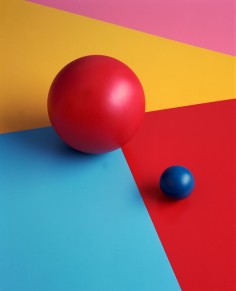Shirana Shahbazi

source: momaorg
Shirana Shahbazi makes photographs in classical art-historical genres, including portraiture, still life, and landscape, often translating and repeating her images in different mediums: hand-knotted carpets, for instance, and photorealistic billboards painted by artisans hired in her native Iran. More recently, Shahbazi has produced work that is architectural in scale, creating installations of multiple images hung on wallpaper. This site-specific installation features a repeated geometric pattern derived from one of the artist’s abstract photographs, printed as a wallpapered lithograph with applied pigment and wrapped around the center wall of the gallery.
Alternating between abstraction and representation, Shahbazi’s vividly colored pictures are made in the crisp style of commercial studio photography, without the aid of digital tools. To make her abstract compositions, she photographs painted pedestals and other geometric volumes; sometimes she makes multiple images of the same objects, turning the volumes between exposures to create a dynamic interplay between surface and depth and a sumptuous field of geometric color and pattern. Shahbazi arranges her pictures in surprising combinations. Here she juxtaposes abstract geometries with the hard edges of jagged mountains and the precise form of a diver in mid-flight. Shahbazi’s arrangements highlight similarities between pictures from different genres and point to structural parallels between outside and inside, organic and manufactured, and the natural and constructed landscape. Her photographs, translated into different mediums and arranged in different groupings each time they are shown, play differently with the viewer’s perception with every new iteration.
Sharina Shahbazi was born in 1974 in Tehran. She studied photography at the Fachhochschule Dortmund in Germany and Hochschule für Gestaltung und Kunst in Zurich. Shahbazi lives and works in Zurich.
.
.
.
.
.
.
.
source: artknowledgenews
Treinado como um fotógrafo na Alemanha e, em seguida, na Suíça, Shahbazi muitas vezes usa suas imagens, que derivam de uma tradição legal e objetiva de fotografia Europeia, com a fonte de material para outdoors pintadas e tapetes feitos à mão. Para isso, ela colabora com pintores iranianos e artesãos. Na curva Shahbazi está trabalhando com pintores quadro de avisos de Teerã para reproduzir suas fotografias na técnica e estilo tipicamente usado para publicidade comercial. Ao alterar a escala e que transpõe as imagens em um novo meio ou um estilo associado a uma outra cultura, ela subverte telespectadores & rsquo; expectativas e explora a complexidade da identidade nacional.
Shirana Shahbazi nasceu em Teerã, em 1974, mudou-se para Stuttgart em 1985, e viveu e trabalhou em Zurique durante a última década. Ela teve exposições individuais no Centre d’Art Contemporain, Genebra, 2005; O Museu de Fotografia Contemporânea, Chicago, 2003 e Galeria dos fotógrafos ‘, Londres, 2001. Seu trabalho também tem sido destaque nas principais exposições coletivas no Museu de Arte Moderna de Nova York, de 2006; Kunstmuseum, Thun, 2006; 4ª Bienal de Berlim de Arte Contemporânea, de 2006; Sharjah Bienal 7, 2005 e Bienal de Veneza de 2003.
.
.
.
.
.
.
.
source: steidlde
Shirana Shahbazi, geboren 1974, studierte Fotografie und Design an der Fachhochschule Dortmund und Fotografie an der HGKZ, Zürich. Ihre Werke waren in zahlreichen Gruppen- und Einzelausstellungen zu sehen und wurden mehrfach ausgezeichnet. Die Künstlerin lebt in der Schweiz.
.
.
.
.
.
.
.
source: biosstars-mx
Nacida en 1974 Shirana Shahbazi es una fotógrafa iraní.
Estudió fotografia en la Universidad de Ciencias y Artes Aplicadas de Dortmund. En Stuttgart, Alemania, comenzó a trabajar como fotógrafa, influenciada por la estética fotográfica tradicional objetiva de esa región de Europa. La preocupación de Shahbazi es documentar la normalidad del universo y manifestar la identidad iraní contemporánea.
Shirana Shahbazi recibió en 2002 el premio de fotografía Citigroup en Londres, gracias a su serie fotográfica “Gotfare Nik”, (Buenas Palabras). Este título está inspirado en un dicho zoroastro en contra de los prejuicios y pretende reflejar la influencia de las imágenes para poder romper estereotipos.
Una de sus obras más importantes es el mural que realizó en 2003 para la 50a. Bienal de Venecia.

